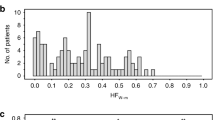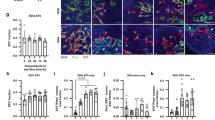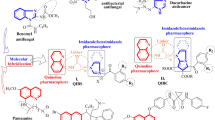Abstract
Pimonidazole is finding increasing use in histochemical analyses of hypoxia in tumours. Whether it can identify every hypoxic cell in a tumour, and whether the usual subjective criteria used to define ‘positive’ cells are optimal, are less certain. Therefore, our aim was to develop an objective flow cytometry procedure for quantifying pimonidazole binding in tumours, and to validate this method by using a more direct indicator of radiobiologic hypoxia, the comet assay. SCCVII tumours in C3H mice were analysed for pimonidazole binding using flow cytometry and an iterative curve-fitting procedure, and the results were compared to the comet assay for the same cell suspensions. On average, cells defined as anoxic by flow analysis (n = 43 tumours) bound 10.8 ± 0.95 times more antibody than aerobic cells. In samples containing known mixtures of aerobic and anoxic cells, hypoxic fractions as low as 0.5% could easily be detected. To assess the flow cytometry assay under a wider range of tumour oxygen contents, mice were injected with hydralazine to reduce tumour blood flow, or allowed to breathe various gas mixtures during the 90 min exposure to pimonidazole. Hypoxic fraction estimated by the pimonidazole binding method agreed well with the hypoxic fraction measured using the comet assay in SCCVII tumours (r2 = 0.87, slope = 0.98), with similar results in human U87 glioma cells and SiHa cervical carcinoma xenografts. We therefore conclude that this objective analysis of pimonidazole labelling by flow cytometry gives a convenient and accurate estimate of radiobiological hypoxia. Preliminary analyses of biopsies from 3 patients given 0.5 g m–2 pimonidazole also suggest the suitability of this approach for human tumours. © 2000 Cancer Research Campaign http://www.bjcancer.com
Similar content being viewed by others
Article PDF
Change history
16 November 2011
This paper was modified 12 months after initial publication to switch to Creative Commons licence terms, as noted at publication
References
Aquino-Parsons C, Luo C, Vikse CM and Olive PL (1999 Comparison between the comet assay and the oxygen microelectrode for measurement of tumour hypoxia. Radiother Oncol 51: 179–185
Brown JM and Giaccia AJ (1998 The unique physiology of solid tumors: opportunities (and problems) for cancer therapy. Cancer Res 58: 1408–1416
Bush RS, Jenkin RDT, Allt WEC, Beale FA, Bean H, Dembo AJ and Pringle JF (1978 Definitive evidence for hypoxic cells influencing cure in cancer therapy. Br J Cancer 37: 302–306
Chapman JD, Dugle DL, Reuvers AP, Meeker BE and Borsa J (1974 Studies on the radiosensitizing effect of oxygen in Chinese hamster cells. Int J Radiat Biol 26: 383–389
Durand RE and Raleigh JA (1998 Identification of nonproliferating but viable hypoxic tumor cells. in vivo. Cancer Res 58: 3547–3550
Falk SJ, Ward R and Bleehen NM (1992 The influence of carbogen breathing on tumour tissue oxygenation in man evaluated by computerised p02 histography. Br J Cancer 66: 919–924
Fyles AW, Milosevic M, Wong R, Kavanagh MC, Pintilie M, Sun A, Chapman W, Levin W, Manchul L, Keane TJ and Hill RP (1998 Oxygenation predicts radiation response and survival in patients with cervix cancer [published erratum appears in Radiother Oncol 1999 Mar; 50(3): 371]. Radiother Oncol 48: 149–156
Hill SA, Collingridge DR, Vojnovic B and Chaplin DJ (1998 Tumour radiosensitization by high-oxygen-content gases: influence of the carbon dioxide content of the inspired gas on PO2, microcirculatory function and radiosensitivity. Int J Radiat Oncol Biol Phys 40: 943–951
Hockel M, Schlenger K, Aral B, Mitze M, Schaffer U and Vaupel P (1996 Association between tumor hypoxia and malignant progression in advanced cancer of the uterine cervix. Cancer Res 56: 4509–4515
Horsman MR, Khalil AA, Siemann DW, Grau C, Hill SA, Lynch EM, Chaplin DJ and Overgaard J (1994 Relationship between radiobiological hypoxia in tumors and electrode measurements of tumor oxygenation. Int J Radiat Oncol Biol Phys 29: 439–442
Kavanagh MC, Tsang V, Chow S, Koch C, Hedley D, Minkin S and Hill RP (1999 A comparison in individual murine tumors of techniques for measuring oxygen levels. Int J Radiat Oncol Biol Phys 44: 1137–1146
Kennedy AS, Raleigh JA, Perez GM, Calkins DP, Thrall DE, Novotny DB and Varia MA (1997 Proliferation and hypoxia in human squamous cell carcinoma of the cervix: first report of combined immunohistochemical assays. Int J Radiat Oncol Biol Phys 37: 897–905
Lee J, Siemann DW, Koch CJ and Lord EM (1996 Direct relationship between radiobiological hypoxia in tumors and monoclonal antibody detection of EF5 cellular adducts. Int J Cancer 67: 372–378
McLaren DB, Pickles T, Thomson T and Olive PL (1997 Impact of nicotinamide on human tumour hypoxic fraction measured using the comet assay. Radiother Oncol 45: 175–182
Olive PL (1989 Distribution, oxygenation, and clonogenicity of macrophages in a murine tumor. Cancer Comm 1: 93–100
Olive PL (1995 Detection of hypoxia by measurement of DNA damage in individual cells from spheroids and murine tumours exposed to bioreductive drugs. I. Tirapazamine. Br J Cancer 71: 529–536
Olive PL and Durand RE (1992 Detection of hypoxic cells in a murine tumor with the use of the comet assay. J Natl Cancer Inst 84: 707–711
Olive PL, Banáth JP and Durand RE (1990 Heterogeneity in radiation-induced DNA damage and repair in tumor and normal cells measured using the “comet” assay. Radiat Res 122: 86–94
Olive PL, Durand RE, LeRiche JC, Olivotto IA and Jackson SM (1993 Gel electrophoresis of individual cells to quantify hypoxic fraction in human breast cancers. Cancer Res 53: 733–736
Olive PL, Horsman MR, Grau C and Overgaard J (1997 Detection of hypoxic cells in a C3H mouse mammary carcinoma using the comet assay. Br J Cancer 76: 694–699
Olive PL, Durand RE, Jackson SM, LeRiche JC, Luo C, Ma R, McLaren DB, Aquino-Parsons C, Thomson TA and Trotter T (1999 The comet assay in clinical practice. Acta Oncol 38: 839–844
Overgaard J (1994 Clinical evaluation of nitroimidazoles as modifiers of hypoxia in solid tumors. Oncol Res 6: 509–518
Raleigh JA, Calkins-Adams DP, Rinker LH, Ballenger CA, Weissler MC, Fowler WCJ, Novotny DB and Varia MA (1998 Hypoxia and vascular endothelial growth factor expression in human squamous cell carcinomas using pimonidazole as a hypoxia marker. Cancer Res 58: 3765–3768
Raleigh JA, Chou SC, Arteel GE and Horsman MR (1999 Comparisons among pimonidazole binding, oxygen electrode measurements, and radiation response in C3H mouse tumours. Radiat Res 151: 580–589
Thrall DE, Rosner GL, Azuma C, McEntee MC and Raleigh JA (1997 Hypoxia marker labeling in tumor biopsies: quantification of labeling variation and criteria for biopsy sectioning. Radiother Oncol 44: 171–176
Varia MA, Calkins-Adams DP, Rinker LH, Kennedy AS, Novotny DB, Fowler WCJ and Raleigh JA (1998 Pimonidazole: a novel hypoxia marker for complementary study of tumor hypoxia and cell proliferation in cervical carcinoma. Gynecol Oncol 71: 270–277
Walton MI, Bleehen NM and Workman P (1989 Effects of localised tumour hyperthermia on pimonidazole (Ro 03–8799) pharmacokinetics in mice. Br J Cancer 59: 667–673
Zhang H, Koch CJ, Wallen CA and Wheeler KT (1995 Radiation-induced DNA damage in tumors and normal tissues. III. Oxygen dependence of the formation of strand breaks and DNA-protein crosslinks. Radiat Res 142: 163–168
Author information
Authors and Affiliations
Rights and permissions
From twelve months after its original publication, this work is licensed under the Creative Commons Attribution-NonCommercial-Share Alike 3.0 Unported License. To view a copy of this license, visit http://creativecommons.org/licenses/by-nc-sa/3.0/
About this article
Cite this article
Olive, P., Durand, R., Raleigh, J. et al. Comparison between the comet assay and pimonidazole binding for measuring tumour hypoxia. Br J Cancer 83, 1525–1531 (2000). https://doi.org/10.1054/bjoc.2000.1489
Received:
Revised:
Accepted:
Published:
Issue date:
DOI: https://doi.org/10.1054/bjoc.2000.1489
Keywords
This article is cited by
-
Thermal Sensitive Liposomes Improve Delivery of Boronated Agents for Boron Neutron Capture Therapy
Pharmaceutical Research (2019)
-
A Hypoxia-Targeted Boron Neutron Capture Therapy Agent for the Treatment of Glioma
Pharmaceutical Research (2016)
-
A tumor hypoxic niche protects human colon cancer stem cells from chemotherapy
Journal of Cancer Research and Clinical Oncology (2013)
-
Evaluation of hypoxia in an experimental rat tumour model by [18F]Fluoromisonidazole PET and immunohistochemistry
British Journal of Cancer (2004)
-
Local hypoxia is produced at sites of intratumour injection
British Journal of Cancer (2002)



